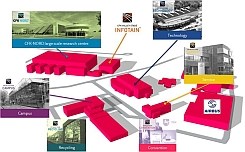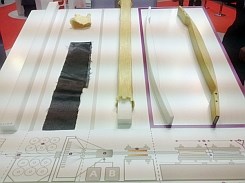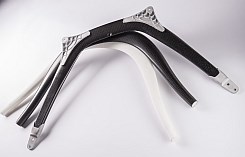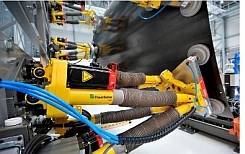Highlights from 10th Intl. CFK Valley Stade Convention 2016
Annual conference featured new carbon composite technologies.

This year’s theme was “Carbon and Mobility” and the partner country was Korea, which is ramping up its own “carbon fiber valley” centered in Jeonju City and Jeonbuk Province.
For those not familiar with CFK Valley, it is a carbon fiber composites association founded in 2004 and headquartered in Stade, Germany, home of Airbus Stade. CTC was formed in 2001, when the R&D group of Airbus Stade was spun off as an independent company. Other local composites companies include Web Industries, Hexcel, Broetje Automation, the DLR Center for Lightweight-Production-Technology (Zentrum für Leichtbauproduktionstechnologie, or ZLP), ACE Advanced Composite Engineering and DOW.
CFK Valley Nord (left) is part of a landscape of carbon fiber composite organizations adjacent to Airbus Stade (right). SOURCE: CFK Valley e.V. and CTC GmbH.
Also a key part of the CFK Valley is CFK Nord, reportedly Europe's largest carbon composites R&D center — located across the street from CTC and Airbus Stade — which houses a variety of composites technology companies and research organizations.
Though CFK Valley was originally focused on northern Germany, it now has members worldwide and has established partnerships in Belgium and Japan.
Exhibition Highlights
A few dozen companies and organizations were represented outside of the conference auditorium. For me, one of the most interesting booths was CTC and Airbus Stade, where a range of samples and brochures described newly developed composites technologies including:
- High-pressure RTM (HP-RTM) for aerospace structures (e.g., a z-frame injected and cured in 9 minutes)
- Automated composite repair scarfing via Mobile Automated Repair Solution (MARS)
- Automated production of CFRP fuselage frames using RTM
- Out-of-autoclave (OOA) structural repair for A350 demonstrated on door corner area
- Advanced assembly concept for vertical tail plane (VTP) using pulse-line work flow
- Striplato – automated Stringer Placement Tool for repeat-precision stringer integration to fulfill upcoming rate requirements
- Automated stringer integration on A350 wing
- Use of thermal camera tool for optimization and troubleshooting of autoclave cure cycles.
Other exhibitors of interest included the automation specialist Fill (Gurten, Austria) and Olin Epoxy (Midland, MI, US), formed in 2015 by Olin Corp.’s (St. Louis, MO, US) acquisition of Dow Epoxy. The latter sells a broad line of epoxy resins (liquids, solids and solutions), novolac resins, curing agents, specialty epoxy tougheners, and fully formulated systems, but excludes those products currently sold via Dow Automotive Systems (Auburn Hills, MI, US).
PulPress technology demonstrated in a strut brace (right) with in situ-formed ROHACELL foam core and carbon fiber braid. SOURCE: Evonik HP Polymers Twitter and The Molding Blog.
Evonik Foams Inc. – ROHACELL (Theodore, AL, US) showcased PulPress technology developed with Secar Technologie GmbH (Mürzzuschlag-Hönigsberg, Austria).The process aims for cost-efficient 3D geometries using an automated continuous process that combines pultrusion and pressing. The process begins by guiding ROHACELL core into fiber reinforcement and resin injections systems, followed by feeding it into a movable press that continuously applies elevated pressure and temperature. The production line now in operation at Secar can produce 30 complex parts/hr using conventional systems, with increased output possible using fast-curing resins. A 30-60% reduction in manufacturing cost is claimed and composite car bumper has been demonstrated at 1/3 the weight and improved crash test performance vs. steel.
Fraunhofer IFAM technologies exhibited at CFK Valley Stade Convention 2016. SOURCE: Fraunhofer IFAM and 2013 CFK Valley Convention presentation.
Fraunhofer Institute for Manufacturing Technology and Advanced Materials IFAM (Bremen, Germany) displayed several projects including:
- Flexible holding fixtures for machining and assembly enable automated and adaptive manipulation of parts 2-6 m long and up to 6m in height using hexapods, linear actuators and modular racks. (Hexapods are robotic positioning devices/manipulators with six degrees of freedom, see Moog and Faulhaber.) Optical sensors can be integrated for part and machine measurement and force/torque sensors provide reliable process control.
- Release agent-free composite part manufacturing using release filmPLASFlex, an elastic polymer, deep-draw film with a flexible plasma-polymer release layer that allows easy removal of parts from molds, even when stretched by 300%. Suitable for both male and female molds, it has been demonstrated in prepreg processing in a 180°C autoclave cure cycle and offers ready-to-paint surfaces without any release agent residues.
There was also a large joint exhibit by a number of Korean composites companies including:
- DACC Aerospace Co. — supplier of fixed trailing edge (FTE) panels for Boeing 787 and 767
- DACC Carbon — produces carbon-carbon and ceramic matrix composite (CMCs) parts for aircraft and automotive brakes as well as aerospace and industrial high-temp applications (e.g. C/Sic elevator brake pads)
- Pitch Cable Inc. — carbon fiber heating elements for roads, outside benches and heating cushions (Jeonju, Korea)
- Korean Institute of Carbon Convergence Technology (KCTECH, Jeonju, Korea)
- Jeollabuk-do Carbon Industry Investment Guidebook was distributed by the city of Jeonbuk and the Carbon Industry Office, Economy and Industry
- NICCA Chemical Co., Ltd. (Seoul, Korea) — Surface modification technique for recycled carbon fiber
I’ll post Conference Highlights next.
Related Content
Plant tour: Albany Engineered Composites, Rochester, N.H., U.S.
Efficient, high-quality, well-controlled composites manufacturing at volume is the mantra for this 3D weaving specialist.
Read MoreInfinite Composites: Type V tanks for space, hydrogen, automotive and more
After a decade of proving its linerless, weight-saving composite tanks with NASA and more than 30 aerospace companies, this CryoSphere pioneer is scaling for growth in commercial space and sustainable transportation on Earth.
Read MoreWelding is not bonding
Discussion of the issues in our understanding of thermoplastic composite welded structures and certification of the latest materials and welding technologies for future airframes.
Read MoreCryo-compressed hydrogen, the best solution for storage and refueling stations?
Cryomotive’s CRYOGAS solution claims the highest storage density, lowest refueling cost and widest operating range without H2 losses while using one-fifth the carbon fiber required in compressed gas tanks.
Read MoreRead Next
“Structured air” TPS safeguards composite structures
Powered by an 85% air/15% pure polyimide aerogel, Blueshift’s novel material system protects structures during transient thermal events from -200°C to beyond 2400°C for rockets, battery boxes and more.
Read MoreAll-recycled, needle-punched nonwoven CFRP slashes carbon footprint of Formula 2 seat
Dallara and Tenowo collaborate to produce a race-ready Formula 2 seat using recycled carbon fiber, reducing CO2 emissions by 97.5% compared to virgin materials.
Read MoreVIDEO: High-volume processing for fiberglass components
Cannon Ergos, a company specializing in high-ton presses and equipment for composites fabrication and plastics processing, displayed automotive and industrial components at CAMX 2024.
Read More




























